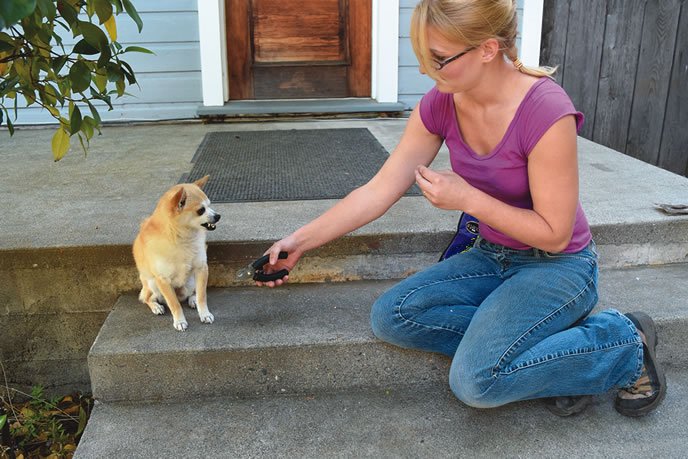[Updated Dec 21, 2022]
I put my hands on my dogs at least a few dozen times a day. It might be to attach or untangle a leash, look into ears, check teeth, brush or trim fur in various places, put on a Thundershirt, apply flea and tick preventative, or just to feel the soft silky warmth of dog under my hand. We humans are a tactile species, and with our handy opposable thumbs, we’re always doing something to manipulate our canine companions and their body parts.
Many dogs love being touched by us as much as we love touching them. When I sit on the sofa in the evenings typing on my laptop, I have dogs snuggled close to me on each side! But dogs aren’t born with a natural love of being touched by humans. They have to learn that human touch is good.
A well-socialized puppy learns early in life that human hands make good things happen. This is classical conditioning – giving your pup a good association with touch (and with all the other things he’s likely to encounter in his lifetime). A well-socialized pup is an optimist, believing that the world is a good place, and new things are safe unless and until proven otherwise. Getting your dog to accept new things throughout his life like Thundershirts, Calming Caps, nail clippers, stethoscopes, and otoscopes is much easier if he is well socialized. (We will publish an article about proper socializing in an upcoming issue.)
If your dog has no problem whatsoever with any kind of husbandry procedure you inflict on him – from trimming nails to getting dressed in a rainsuit, well, count your lucky stars, and show him your appreciation for his continued cooperation!
Dog Hates Being Touched?
But what if, for whatever reason, your dog hates being touched? Or maybe he likes being petted, but won’t let you pick him up, or won’t allow you to look for and carefully pull off a tick? Or maybe it’s just that he hates a certain procedure, whether it’s getting his ears cleaned or his teeth brushed.
“Counter-conditioning” is the most powerful tool to use to literally counter those negative responses. Counter-conditioning is the process of changing your dog’s existing association with something from one state to another – usually from negative to positive.
As an example, say someone once made the mistake of muzzling your dog and forcibly holding him down while clipping his nails; your dog probably now thinks nail trimming is a terrifying ordeal. You can use counter-conditioning to convince him, instead, that nail trimming is a wonderful thing, by pairing bits and pieces of the nail trimming process with high-value treats, and gradually putting the whole process together. You are working to convince your dog that nail trimming actually makes really good stuff happen.
But that’s not all you can do! You can use counter-conditioning to invite your dog to willingly and happily participate in the process of any husbandry procedure that is currently problematic for her. I’ll discuss the “how” of the process for several different procedures in just a moment.
Creating Opportunities for Making Choices for Your Dog
We humans tend to be happier with our lives when we can make our own choices. Our dogs do, too! The better we are at giving them opportunities to make choices for themselves and setting them up to want to make the right choices, the happier we all are. If you can convince your dog to willingly and happily choose to participate in a husbandry procedure, everyone is better off.
An alternative to the above-described counter-conditioning for nail trimming is to provide your dog with a canine-sized emery board, teach him to use it, and let him choose to file his own nails. (Note: Some owners report that their dogs love to file their own nails so much that they have to put the board away or their dogs file their nails down to the bloody quick.)
Whatever procedures you use, you can set your dog up for success by “priming” before you begin.
Priming is a behavioral effect in which exposure to a stimulus influences a response to a later stimulus. While well documented in human behavior, the concept of priming is less-known in the world of dog training and behavior. Simply put, if you “prime” your dog with tasty treats or a fun activity prior to engaging in the handling activity, your dog is in a happier frame of mind to begin the procedure, and thus better able to make choices and respond from a less stressful place.
Here are some handling challenges and how you can use choice and counter-conditioning protocols to make life less stressful for you and your dog:
Putting on a Harness (or Thundershirt, Jacket, etc)
This may seem tedious, but it’s important to understand that breaking each activity down into many small steps accomplishes two things. First, it helps your dog understand what it is that you want. Second, it makes the learning process much more engaging and enjoyable for him.
There are countless procedures that involve touching and handling our dogs, and each could be spelled out in a protocol that uses choice, classical conditioning, or a combination of the two, to make life easier for both you and your dog. But I bet by now you’ve got the idea.
Your dog’s challenge might be the application of topical flea and tick preventative, cleaning and/or putting medication in ears, electric clippers, flea combing, brushing teeth, pulling ticks, or something else. No matter which challenge it is, it’s always better to figure out how to help your dog become a willing partner in the activity than to restrain and force him into accepting the procedure. Unless it’s a medical emergency, there’s no need to use force!





